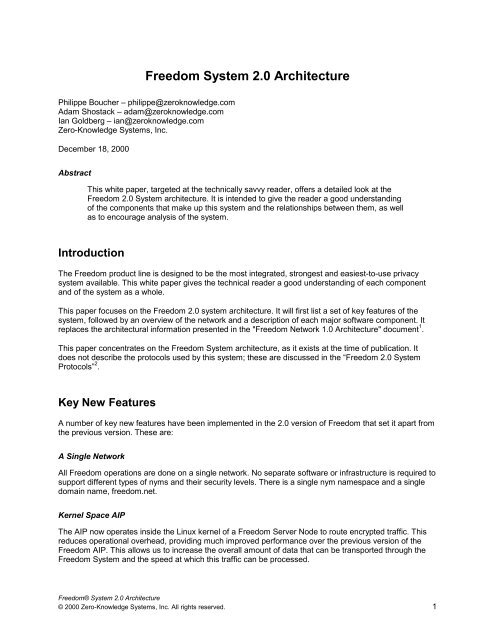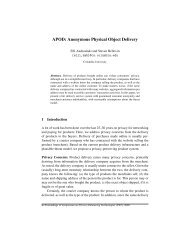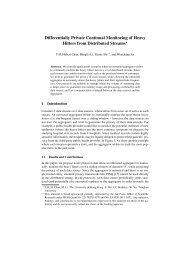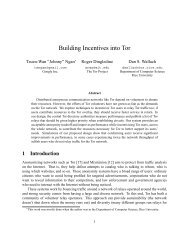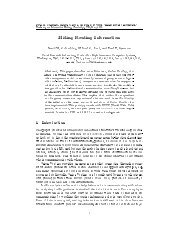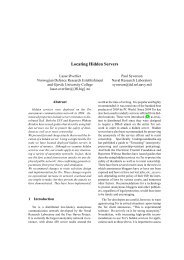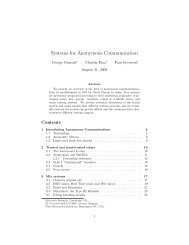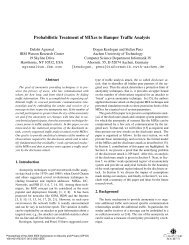Freedom System 2.0 Architecture - Osiris
Freedom System 2.0 Architecture - Osiris
Freedom System 2.0 Architecture - Osiris
Create successful ePaper yourself
Turn your PDF publications into a flip-book with our unique Google optimized e-Paper software.
<strong>Freedom</strong> <strong>System</strong> <strong>2.0</strong> <strong>Architecture</strong><br />
Philippe Boucher – philippe@zeroknowledge.com<br />
Adam Shostack – adam@zeroknowledge.com<br />
Ian Goldberg – ian@zeroknowledge.com<br />
Zero-Knowledge <strong>System</strong>s, Inc.<br />
December 18, 2000<br />
Abstract<br />
This white paper, targeted at the technically savvy reader, offers a detailed look at the<br />
<strong>Freedom</strong> <strong>2.0</strong> <strong>System</strong> architecture. It is intended to give the reader a good understanding<br />
of the components that make up this system and the relationships between them, as well<br />
as to encourage analysis of the system.<br />
Introduction<br />
The <strong>Freedom</strong> product line is designed to be the most integrated, strongest and easiest-to-use privacy<br />
system available. This white paper gives the technical reader a good understanding of each component<br />
and of the system as a whole.<br />
This paper focuses on the <strong>Freedom</strong> <strong>2.0</strong> system architecture. It will first list a set of key features of the<br />
system, followed by an overview of the network and a description of each major software component. It<br />
replaces the architectural information presented in the "<strong>Freedom</strong> Network 1.0 <strong>Architecture</strong>" document 1 .<br />
This paper concentrates on the <strong>Freedom</strong> <strong>System</strong> architecture, as it exists at the time of publication. It<br />
does not describe the protocols used by this system; these are discussed in the “<strong>Freedom</strong> <strong>2.0</strong> <strong>System</strong><br />
Protocols” 2 .<br />
Key New Features<br />
A number of key new features have been implemented in the <strong>2.0</strong> version of <strong>Freedom</strong> that set it apart from<br />
the previous version. These are:<br />
A Single Network<br />
All <strong>Freedom</strong> operations are done on a single network. No separate software or infrastructure is required to<br />
support different types of nyms and their security levels. There is a single nym namespace and a single<br />
domain name, freedom.net.<br />
Kernel Space AIP<br />
The AIP now operates inside the Linux kernel of a <strong>Freedom</strong> Server Node to route encrypted traffic. This<br />
reduces operational overhead, providing much improved performance over the previous version of the<br />
<strong>Freedom</strong> AIP. This allows us to increase the overall amount of data that can be transported through the<br />
<strong>Freedom</strong> <strong>System</strong> and the speed at which this traffic can be processed.<br />
<strong>Freedom</strong>® <strong>System</strong> <strong>2.0</strong> <strong>Architecture</strong><br />
© 2000 Zero-Knowledge <strong>System</strong>s, Inc. All rights reserved. 1
Scalable Core <strong>System</strong>s<br />
The various servers that comprise the <strong>Freedom</strong> Core <strong>System</strong>s have been made scalable. Multiple<br />
instances of each server type can now be run to support the needs of a greater number of <strong>Freedom</strong><br />
clients.<br />
A Clearly Defined Threat Model<br />
A cleaner threat model 3 for the <strong>Freedom</strong> <strong>System</strong> has been defined. This allows the <strong>Freedom</strong> <strong>System</strong><br />
design to better focus against attacks that we can defend against, and removes certain constraints that<br />
interfere with the <strong>Freedom</strong> <strong>System</strong>'s network performance.<br />
A New Mail <strong>System</strong><br />
The reply block mail system has been completely replaced by a POP box-based mail system hosted by<br />
Zero-Knowledge <strong>System</strong>s, Inc. This dramatically increases the performance of the system. It can support<br />
a large number of users and provides them with simpler, more secure, and faster mail services.<br />
<strong>Freedom</strong> <strong>System</strong> Overview<br />
The <strong>Freedom</strong> Network is an overlay network that runs on top of the Internet. It uses layers of encryption to<br />
allow a <strong>Freedom</strong> user to engage in a wide variety of pseudonymous activities, hiding the user's real IP<br />
address, email address, and other identifying information from eavesdroppers and active attempts to<br />
violate the user's privacy.<br />
Users are encouraged to create pseudonyms ("nyms") for each area of activity in which they want to<br />
preserve their privacy. The nyms that someone uses cannot be tied together. Thus, it is not possible to<br />
know if superman@freedom.net and clarkkent@freedom.net are the same or different people. Superman<br />
is happy with this situation because he doesn't want his super villain enemies to know about his life.<br />
Similarly, when jobseeker@freedom.net browses a resume web site, his employer cannot see that Clark<br />
("jobseeker") isn't happy with his job at the Daily Planet and wants to work elsewhere. <strong>Freedom</strong> protects<br />
Clark's privacy by proxying the various supported protocols, and sending those proxied packets through a<br />
private network before they are deposited on the Internet for normal service. That private network, as a<br />
system, is operated by Zero-Knowledge. Individual nodes in the network are operated by Zero-Knowledge<br />
or our partners, so that no single operator has comprehensive knowledge of what data is flowing through<br />
the network. Thus, the main components of the system are <strong>Freedom</strong> Clients and <strong>Freedom</strong> Servers. In the<br />
next section, we offer precise definitions of these and other entities.<br />
<strong>Freedom</strong> Network Layout<br />
The <strong>Freedom</strong> <strong>System</strong> consists of a set of <strong>Freedom</strong> Server Nodes that make up the <strong>Freedom</strong> Network,<br />
and the <strong>Freedom</strong> Core Servers that provide basic services. The network transports encrypted IP traffic<br />
from one node to the next. Nodes on the <strong>Freedom</strong> Network are called Anonymous Internet Proxies (AIPs).<br />
The number of nodes used in a route is chosen by the user by setting her security level in the <strong>Freedom</strong><br />
client. The server nodes themselves are not linked by a fixed topology, instead, they can communicate<br />
with any other server node on the network, as requested by a client when creating a route. The <strong>Freedom</strong><br />
client is given a network topology that identifies a set of reliable links between nodes in order to simplify<br />
route selection. This topology is defined solely on the basis of AIP-AIP performance characteristics.<br />
<strong>Freedom</strong>® <strong>System</strong> <strong>2.0</strong> <strong>Architecture</strong><br />
© 2000 Zero-Knowledge <strong>System</strong>s, Inc. All rights reserved. 2
Figure 1: <strong>Freedom</strong> Network Layout<br />
Authenticated routes to an exit AIP are granted through route creation requests signed by a nym. Upon<br />
receipt of such a request, an AIP will retrieve the requesting nym's public signature key and verify the<br />
request. Only nyms that have full access to the network can create such a route. Authenticated routes<br />
allow access to any host on the Internet.<br />
Unauthenticated routes to a core AIP are granted to any <strong>Freedom</strong> client that requests one. These are<br />
limited in that only <strong>Freedom</strong> core servers can be accessed.<br />
The core servers consist of PKI server clusters, reporting and network information server clusters, a token<br />
server, and the mail system. The core servers are accessed by creating completely anonymous routes<br />
that terminate at a core AIP. These are the only AIPs on the <strong>Freedom</strong> Network capable of accessing the<br />
core servers.<br />
<strong>Freedom</strong> Network Server Nodes<br />
A <strong>Freedom</strong> server node is a host running part of the <strong>Freedom</strong> Network. This node can be administered by<br />
Zero-Knowledge or by a third party server operator. A <strong>Freedom</strong> server node consists of an AIP, a local<br />
NIQS daemon client, some administration utilities and a set of key management utilities.<br />
The node's operator generates the signature and encryption keys and submits the public components to<br />
Zero-Knowledge <strong>System</strong>s for distribution to the rest of the network. Zero-Knowledge <strong>System</strong>s never sees<br />
the node's private keys, ensuring that only that node is capable of decrypting its layer from the traffic that<br />
goes through it.<br />
<strong>Freedom</strong>® <strong>System</strong> <strong>2.0</strong> <strong>Architecture</strong><br />
© 2000 Zero-Knowledge <strong>System</strong>s, Inc. All rights reserved. 3
The server node software needs to be able to communicate with the key query servers, NIQS, NISS, and<br />
other AIPs on the <strong>Freedom</strong> Network. It accepts connections from <strong>Freedom</strong> clients wanting to transport<br />
encrypted IP traffic on the <strong>Freedom</strong> Network.<br />
A <strong>Freedom</strong> server node also runs a DNS server that is used to respond to DNS queries generated by a<br />
<strong>Freedom</strong> client. This is done through the same authenticated route as the client that issued the query,<br />
thus ensuring that any hostname lookup done by a <strong>Freedom</strong> user pseudonymous and private.<br />
<strong>Freedom</strong> Core <strong>System</strong>s<br />
The <strong>Freedom</strong> Core <strong>System</strong>s provide the base services that keep the <strong>Freedom</strong> Network running. This<br />
includes providing public keys, nym creation and update, network information and reporting, token<br />
creation, and the mail system. All of these services are currently provided by Zero-Knowledge and are<br />
located within our machine room. This new architecture introduces the concept of a core AIP that allows<br />
unauthenticated connections to any of the core servers in the network. The servers are no longer<br />
constrained by performance limitations or affected by the AIP running on the same host, as they were in<br />
the previous version of the system. Multiple instances of each core server type are also now supported.<br />
This allows the <strong>Freedom</strong> <strong>System</strong> core to load balance incoming requests across several machines as<br />
required.<br />
Software Components<br />
This section describes the <strong>Freedom</strong> <strong>System</strong> components that make up the architecture design, including<br />
the <strong>Freedom</strong> client, AIP, network information and reporting system, PKI servers, and the mail system.<br />
<strong>Freedom</strong> Client<br />
The <strong>Freedom</strong> client allows networking applications running on a computer to access the Internet through<br />
the <strong>Freedom</strong> <strong>System</strong>. It is designed to work seamlessly with these applications by trapping and redirecting<br />
the data streams that they generate. What follows is a simplified description of the client that applies to<br />
both the Windows and Linux versions. A more thorough description is beyond the needs and scope of this<br />
document.<br />
The <strong>Freedom</strong> client consists of several components: a graphical user interface, a network access layer, a<br />
traffic filter, application filters, and a set of libraries that implement the functionality required for encryption,<br />
routing, nym management, route creation, etc.<br />
<strong>Freedom</strong>® <strong>System</strong> <strong>2.0</strong> <strong>Architecture</strong><br />
© 2000 Zero-Knowledge <strong>System</strong>s, Inc. All rights reserved. 4
Figure 2: <strong>Freedom</strong> Client Internal <strong>Architecture</strong><br />
The interface allows a user to control the operation of the various components. It creates and destroys<br />
routes in the <strong>Freedom</strong> <strong>System</strong>, updates network information, manages pseudonymous identities and<br />
controls the application and traffic filters.<br />
The network access layer is used to trap an application's networking calls such as connect() and sendto()<br />
and redirects them to the local application filters. This allows the application filter to see the original data<br />
stream generated by a network application and the response data stream generated by the destination<br />
host of the requested connection. After the local application filters have processed the data, the<br />
networking calls continue through the <strong>Freedom</strong> client host's networking stacks.<br />
<strong>Freedom</strong>® <strong>System</strong> <strong>2.0</strong> <strong>Architecture</strong><br />
© 2000 Zero-Knowledge <strong>System</strong>s, Inc. All rights reserved. 5
The application filters are used to sanitize a network application's data stream. Many application protocols<br />
such as SMTP and HTTP will reveal information about a user; the filters edit or remove this information by<br />
parsing the stream according to the appropriate protocol and reconstructing a new sanitized stream. As<br />
responses arrive from a remote host back through the filter, the stream is again processed so that the<br />
local network application is not aware of the changes that have taken place. This allows the <strong>Freedom</strong><br />
client to implement functionality such as the Cookie Manager and the Ad Manager without hindering the<br />
operation of the user's applications<br />
After the data stream is returned from the application filter and the network access layer, it enters the<br />
client host's networking stack. This converts the data stream to IP, TCP, and UDP datagrams. Instead of<br />
allowing the host to place these datagrams directly on its network connection, the datagrams are picked<br />
up by the <strong>Freedom</strong> traffic filter. This filter sanitizes the datagrams by removing the source IP address,<br />
TCP and IP checksums, and zeroing out other fields. The datagram is then encrypted for the route that<br />
has been created for the active nym. The encrypted datagram is now sent to the first <strong>Freedom</strong> Server<br />
Node in the route. Returning traffic is processed in reverse. Datagrams are decrypted according to the<br />
route parameters, the headers are reconstructed and the traffic filter injects the datagram back into the<br />
client host networking stacks. These are sent through the application filters and back to the network<br />
application. This method allows the networking stack on the <strong>Freedom</strong> client host and the remote<br />
networking stack to negotiate a connection with each other without being aware that the <strong>Freedom</strong> <strong>System</strong><br />
is transporting the traffic.<br />
The <strong>Freedom</strong> Client currently supports the following protocols through its application filters:<br />
• HTTP: All types of HTTP requests can be sanitized.<br />
• SMTP: SMTP mail is trapped and sent to the <strong>Freedom</strong> Mail <strong>System</strong>.<br />
• POP: The POP filter will connect to the user's regular POP server as well as the <strong>Freedom</strong> Mail<br />
<strong>System</strong>. It will automatically decrypt and authenticate <strong>Freedom</strong> messages.<br />
• SSL: The SSL filter is only able to verify that the datastream follows the SSL protocol. It cannot<br />
decrypt it to verify the contents.<br />
• IRC: Basic IRC is supported but DCC is not.<br />
• Telnet: In order to speed up performance, telnet is run in line buffer mode in order to reduce the<br />
number of packets that must be transported. This filter is also able to support SSH.<br />
• NNTP: NNTP is supported for post only. Usenet posts are redirected through the <strong>Freedom</strong> Mail<br />
<strong>System</strong> and sent to a commercial news server affiliated with Zero-Knowledge <strong>System</strong>s, Inc. Currently,<br />
news must be read from the web.<br />
The <strong>Freedom</strong> Mail <strong>System</strong> is closely linked to the SMTP and POP application filters. On top of the<br />
sanitization work done by these filters, they also encrypt, decrypt, reconstruct and scan messages, using<br />
the appropriate keys as required by the selected nym. This allows the <strong>Freedom</strong> client to seamlessly<br />
integrate a user's preferred mail application into the <strong>Freedom</strong> <strong>System</strong>.<br />
Masquerading AIP<br />
The Anonymous Internet Proxies (AIPs) are the core network privacy daemons that make up the <strong>Freedom</strong><br />
Network. They pass encapsulated network packets between themselves until they reach an exit node. The<br />
masquerading AIP is incorporated into the Linux kernel in order to access the kernel's networking<br />
features. This allows the AIP to route large amounts of network traffic efficiently. A user-level daemon<br />
handles reliability-demanding operations such as key negotiations.<br />
<strong>Freedom</strong>® <strong>System</strong> <strong>2.0</strong> <strong>Architecture</strong><br />
© 2000 Zero-Knowledge <strong>System</strong>s, Inc. All rights reserved. 6
Figure 3: <strong>Freedom</strong> <strong>2.0</strong> Masquerading AIP<br />
The Masquerading AIP for release <strong>2.0</strong> has a number of features that set it apart from the previous version<br />
of the <strong>Freedom</strong> AIP:<br />
• The Masquerading AIP does not use fixed packet sizes--it allows variable packet sizes. This greatly<br />
lowers the bandwidth transport overhead since only relevant information is transported.<br />
• The Masquerading AIP is able to transport some ICMP traffic through the <strong>Freedom</strong> Network. This<br />
allows entities communicating through the <strong>Freedom</strong> Network to have better control of their TCP<br />
streams.<br />
• The Masquerading AIPs have no knowledge of the <strong>Freedom</strong> Network topology. Although a list of<br />
<strong>Freedom</strong> server nodes is provided to each AIP, the AIPs are free to connect to any other AIP on the<br />
network. Although the client is still provided with a topology, it is now only used by the client as a<br />
guide.<br />
• The kernel's own networking stack is used to reconstruct traffic going out to the Internet. This<br />
provides a high level of performance and functionality<br />
• Bandwidth limiting is available.<br />
<strong>Freedom</strong>® <strong>System</strong> <strong>2.0</strong> <strong>Architecture</strong><br />
© 2000 Zero-Knowledge <strong>System</strong>s, Inc. All rights reserved. 7
• There is no cover traffic. In order to meet the current security threat model 3 , cover traffic is not<br />
required. This improves performance by reducing the amount of "garbage" data on the network and<br />
reducing the "throw away" overhead that is required by an AIP to process a packet.<br />
• An unauthenticated route allows a client to connect to a number of predetermined hosts. This allows<br />
the core AIPs to grant access to any of the core servers, thus allowing the <strong>Freedom</strong> core to better<br />
load balance incoming connections.<br />
The Masquerading AIP obtains network information describing nodes and servers within the <strong>Freedom</strong><br />
<strong>System</strong> from an NIQS server. It uses the key query server in order to lookup nym public signature keys<br />
that are used to sign authenticated route creation requests. The AIP will periodically report its status to a<br />
<strong>Freedom</strong> NISS server.<br />
The capacity of the <strong>Freedom</strong> Network can be scaled up simply by adding new AIPs. Since there is no<br />
topology, each new AIP can be fully used to support new users.<br />
Network Information and Reporting<br />
The <strong>Freedom</strong> <strong>System</strong>'s network information and reporting capability is made up of nodes that contain<br />
three different components. There is an NISS server to receive status updates from server entities in the<br />
<strong>Freedom</strong> <strong>System</strong>, a network information database (NIDB) to store the information, and an NIQS server<br />
that mines this database to answer network information queries for all entities in the <strong>Freedom</strong> <strong>System</strong>. As<br />
status updates arrive at the <strong>Freedom</strong> Core, they are replicated and a copy is sent to each network<br />
information node.<br />
<strong>Freedom</strong>® <strong>System</strong> <strong>2.0</strong> <strong>Architecture</strong><br />
© 2000 Zero-Knowledge <strong>System</strong>s, Inc. All rights reserved. 8
Figure 4: Network Information and Reporting <strong>System</strong><br />
The <strong>Freedom</strong> <strong>2.0</strong> NIQS server adds a number of features that significantly improve the speed of a<br />
<strong>Freedom</strong> client's network update and the overall number of <strong>Freedom</strong> clients that can simultaneously query<br />
<strong>Freedom</strong> Network information. These improvements include:<br />
• Compressed network description. A new NIQS command returns the entire network description in a<br />
single response with a single signature. This response is compressed and fully downloaded only when<br />
it differs from the client's local version of the network representation. Although individual entity records<br />
can be queried, the <strong>Freedom</strong> <strong>2.0</strong> client only downloads this compressed information.<br />
• The NIQS does not provide real time network status. The <strong>Freedom</strong> <strong>2.0</strong> client maintains its own<br />
statistics on network performance and availability. This allows it to provide a more meaningful view of<br />
the network to the user. As a result, the NIQS server no longer needs to provide this information.<br />
Instead, the NIQS only notifies <strong>Freedom</strong> clients when a <strong>Freedom</strong> server is marked as unavailable for<br />
system administration purposes. This reduces the amount of recomputation that must be done by the<br />
NISS and NIQS since <strong>Freedom</strong> Network entity records do not need to be rebuilt as a result of<br />
<strong>Freedom</strong> server status updates.<br />
<strong>Freedom</strong>® <strong>System</strong> <strong>2.0</strong> <strong>Architecture</strong><br />
© 2000 Zero-Knowledge <strong>System</strong>s, Inc. All rights reserved. 9
• Reduced client update frequency. Because the <strong>Freedom</strong> client maintains its own statistics on the<br />
network, the client's update frequency for <strong>Freedom</strong> Network information is greatly reduced. It is<br />
currently set to once every 4 hours of operation.<br />
The <strong>Freedom</strong> client does not receive real-time status information on the <strong>Freedom</strong> Network. Instead, it<br />
maintains its own statistics regarding the state of the network based on its accesses to it.<br />
<strong>Freedom</strong> <strong>System</strong> Entities<br />
Each distinct component type in the <strong>Freedom</strong> <strong>System</strong> is known as an entity. These entities can be<br />
software components, such as an AIP or a nym server, or a data object, such as a nym, or a special<br />
purpose keyset. The entities are organized into a hierarchy that is used to delegate authentication<br />
authority. This is further explained in the Signature Key Hierarchy section. The NIQS serves description<br />
information concerning all entities except ZkMaster, FrYear, FrMonth, and Nym.<br />
Most entities have both a signature key pair and an encryption key pair. In some cases however, only one<br />
type of key pair is used by the entity.<br />
ZkMaster<br />
FrYear<br />
FrMonth<br />
TokSrv<br />
NymSrv<br />
Niqs<br />
Niss<br />
Nmta<br />
Imep<br />
Pop<br />
KeyQry<br />
Nym<br />
This entity is used by the Zero-Knowledge master key for the <strong>Freedom</strong><br />
<strong>System</strong>. The public component of this key is hardwired into every piece of<br />
<strong>Freedom</strong> software.<br />
This is the Zero-Knowledge <strong>Freedom</strong> yearly key. Once per year, this key is<br />
used to sign all keys below it in the hierarchy.<br />
This is the Zero-Knowledge <strong>Freedom</strong> monthly key. This key is used to sign<br />
all keys below it in the hierarchy.<br />
This is the token server entity.<br />
This is the nym server entity.<br />
This is the NIQS server entity.<br />
This is the NISS server entity.<br />
The NMTA is the mail system server that processes mail sent from a nym<br />
and arriving at the <strong>Freedom</strong> <strong>System</strong> core.<br />
The IMEP is the mail system server that processes mail sent from an<br />
Internet user to a nym and arriving at the <strong>Freedom</strong> <strong>System</strong> core.<br />
Pop server entities can be accessed by nyms in order to download their<br />
mail.<br />
This is the key query server entity.<br />
This is the entity used for all nyms in the <strong>Freedom</strong> <strong>System</strong> regardless of the<br />
actual type of the nym.<br />
<strong>Freedom</strong>® <strong>System</strong> <strong>2.0</strong> <strong>Architecture</strong><br />
© 2000 Zero-Knowledge <strong>System</strong>s, Inc. All rights reserved. 10
PKI <strong>System</strong>s<br />
The PKI servers consist of three types of server, a key query server, a nym server, and token server. A<br />
nym server is used to create and manage a <strong>Freedom</strong> client user's pseudonymous identities. A key query<br />
server is used to provide public keys on request to <strong>Freedom</strong> servers and clients. The token server<br />
provides nym creation tokens, which allow a user to anonymously create nyms without identifying their real<br />
identity.<br />
The basic architecture is shown in the diagram below. The Key Query Server provides access to public<br />
signature and encryption keys for all entities on the <strong>Freedom</strong> Network. It is used by all entities in order to<br />
validate signatures and keys that they receive in the course of their activities.<br />
Figure 5: <strong>Freedom</strong> <strong>2.0</strong> PKI Subsystems<br />
Signature Key Hierarchy<br />
The key query server provides signed public keys in response to requests from various <strong>Freedom</strong> entities.<br />
These responses are signed following a hierarchy that ultimately allows a <strong>Freedom</strong> client to authenticate<br />
them.<br />
There is a set of keys at the top of the hierarchy that are used only for signing. These keys include the<br />
Master, Yearly, and Monthly keys. The Monthly key signs the signature keys for all of the <strong>Freedom</strong><br />
<strong>System</strong>'s servers. There is a Master key, whose public parameters are encoded into all <strong>Freedom</strong> software<br />
for reference. The Master key is a 2048 bit DSA key, using the same prime parameters as are used in<br />
<strong>Freedom</strong>® <strong>System</strong> <strong>2.0</strong> <strong>Architecture</strong><br />
© 2000 Zero-Knowledge <strong>System</strong>s, Inc. All rights reserved. 11
PGP. The Master Key signs a Yearly key. The Yearly key is 1024 bit DSA; it is used to sign the Monthly<br />
key and client software updates.<br />
Each <strong>Freedom</strong> server entity signs its own public encryption key using its private signature key. The<br />
NymSrv key also signs the Nym signature keys. The Monthly key, and the keys it signs, is stored online.<br />
The nym server provides a way for clients to create and manage pseudonymous identities. It functions as<br />
a nym directory service for the <strong>Freedom</strong> <strong>System</strong>. The token server allows the <strong>Freedom</strong> client to redeem<br />
an activation code for a set of nym creation and upgrade tokens. This allows pseudonymous identity<br />
creation to occur without being able to track a nym back to the originally purchased activation code. For<br />
details on this process, please refer to the paper "Untraceable Nym Creation on the <strong>Freedom</strong> <strong>2.0</strong><br />
Network" 4 . A nym can be revoked by deleting its keys from the public key databases. This makes a nym<br />
unable to use the system within a few hours as cached copies of its keys expire in the AIP key caches.<br />
These caches set a TTL of a few hours on each public nym signature key.<br />
Figure 6: Key Hierarchy<br />
The <strong>Freedom</strong> <strong>System</strong> supports multiple types of nyms, each with different capabilities. These nyms are<br />
identified by a type number that implies a certain set of capabilities common to all nyms of that type.<br />
These capabilities can be arbitrarily changed. The ability to upgrade from one nym type to another is<br />
currently disabled.<br />
Premium These full access nyms are offered by the <strong>Freedom</strong> <strong>System</strong>. These currently<br />
have access to all of the system's capabilities, including the mail system,<br />
authenticated and unauthenticated route creation.<br />
Standard Standard nyms are created in the <strong>Freedom</strong> <strong>System</strong>. However, they can do<br />
nothing other than nym management operations on the nym server and create<br />
unauthenticated routes to the <strong>Freedom</strong> <strong>System</strong> core. These nyms exist to allow<br />
<strong>Freedom</strong>® <strong>System</strong> <strong>2.0</strong> <strong>Architecture</strong><br />
© 2000 Zero-Knowledge <strong>System</strong>s, Inc. All rights reserved. 12
a user to reserve an entry in the nym namespace and to facilitate the use of<br />
certain <strong>Freedom</strong> client features such as cookie management, the form filler, ad<br />
manager, and the personal firewall. These nyms are not able to create<br />
authenticated routes on the <strong>Freedom</strong> Network.<br />
The token server is used to redeem activation codes for nym creation and upgrade tokens. This<br />
transaction is done anonymously through the <strong>Freedom</strong> Network. This layer of indirection in the nym<br />
creation process ensures that a nym cannot be tracked back to its owner when it is created.<br />
The PKI systems interact with most other components of the <strong>Freedom</strong> <strong>System</strong>. AIPs lookup public<br />
signature keys for nyms that sign route creation requests. The nym server creates mail access certificates<br />
that are returned to the client and are in turn passed to the mail system to create nym mail accounts. The<br />
<strong>Freedom</strong> client uses the nym server to create and modify new nyms. The PKI servers themselves obtain<br />
network information from the network information system's NIQS server and report their status to the<br />
NISS<br />
Database <strong>System</strong>s<br />
The <strong>Freedom</strong> databases are accessed through the PKI and Network information servers. Any response<br />
generated by one of these servers will always be signed by the server's signature key.<br />
Nym Database<br />
The nym database holds all publicly available information that describes each nym. None of the stored<br />
information reveals the true identity of a nym owner. This database can be queried by anyone, but only the<br />
owner of a nym is allowed to modify a nym record. When a nym is created, that entry in the nym name<br />
space becomes permanent. If the owner of a nym decides to destroy their nym, or the nym expires, that<br />
nym name is not returned to the name space and it cannot be used by another <strong>Freedom</strong> user.<br />
Public Keys<br />
The public key database holds the public signature and encryption keys for all entities in the <strong>Freedom</strong><br />
<strong>System</strong>, including nyms and servers. All keys are stored signed, according to the <strong>Freedom</strong> key hierarchy.<br />
When a public key lookup is made by a <strong>Freedom</strong> entity, it needs to lookup the keys used to sign the<br />
request key in order to verify the validity of the response. These extra keys are cached by the requesting<br />
entity in order to reduce extra key lookups.<br />
Spent Tokens<br />
The spent token database is used to prevent a nym creation or upgrade token from being reused. When<br />
an attempt to spend a token at a nym server is made, the database is searched for a hash of the token. If<br />
it is found, the token has already been used and is therefore refused. If it is not found, the hash is stored in<br />
the database and the token is accepted. The hash of the token is not linked to any other piece of<br />
information.<br />
Activation Code Database<br />
The activation code database is used by the token server to keep track of activation codes that can<br />
currently be redeemed by users. Each activation code has an associated capability code that is used to<br />
determine the type and number of tokens that are generated when the activation code is redeemed. There<br />
is no token database. These are generated and signed as required by the token server.<br />
<strong>Freedom</strong>® <strong>System</strong> <strong>2.0</strong> <strong>Architecture</strong><br />
© 2000 Zero-Knowledge <strong>System</strong>s, Inc. All rights reserved. 13
Network Information Database (NIDB)<br />
This database maintains information regarding all <strong>Freedom</strong> server entities. An entity record can be<br />
queried independently, or a complete compressed description of the entire network can be queried.<br />
Reporting Database<br />
This database is maintained by the NISS using the status updates that are sent to it from the various<br />
<strong>Freedom</strong> servers. It keeps track of things such as the uptime of each server, the number of bytes<br />
transferred, the number of messages processed, etc. This database is used to manage the <strong>Freedom</strong><br />
<strong>System</strong>.<br />
Mail <strong>System</strong><br />
The <strong>Freedom</strong> mail system handles all mail sent to and by nyms. It uses the <strong>Freedom</strong> Network to<br />
anonymously deliver mail messages and uses a POP box in the <strong>Freedom</strong> Core to store mail that is to be<br />
read by nyms.<br />
The POP mail system completely replaces <strong>Freedom</strong>'s original Reply Block based mail system. Where<br />
possible, the design reuses proven and existing technology, generated both internally and externally of<br />
Zero-Knowledge <strong>System</strong>s, rather than designing and implementing our own custom solution set.<br />
The design for the POP mail solution is based on qmail 5 , an open and freely available software suite that<br />
has gained popularity as the basis for reliable, high performance systems. qmail is a highly modular<br />
software solution. The new mail system design and implementation embraces this philosophy; each of the<br />
subcomponents, which are needed in order to modify a stock qmail installation to the purposes of the<br />
<strong>Freedom</strong> Network, is a small, loosely coupled, and crisply defined unit of functionality. The assembly and<br />
integration of these units form the functionally complete mail system.<br />
<strong>Freedom</strong>® <strong>System</strong> <strong>2.0</strong> <strong>Architecture</strong><br />
© 2000 Zero-Knowledge <strong>System</strong>s, Inc. All rights reserved. 14
Figure 7: <strong>Freedom</strong> <strong>2.0</strong> Mail <strong>System</strong><br />
There are three new entity types for the mail system: POP, IMEP, and NMTA. The POP entity is the<br />
<strong>Freedom</strong> POP server that is accessed via the local pop proxy on a <strong>Freedom</strong> client when it wishes to<br />
download a nym's mail. The NMTA (Nym Mail Transfer Agent) entity is used to process mail from a nym.<br />
The IMEP (Internet Mail Encryption Proxy) is used to process mail from an Internet user to a nym. The<br />
<strong>Freedom</strong>® <strong>System</strong> <strong>2.0</strong> <strong>Architecture</strong><br />
© 2000 Zero-Knowledge <strong>System</strong>s, Inc. All rights reserved. 15
IMEP and NMTA are essentially queuing mechanisms used to grab mail messages. The IMEP and NMTA<br />
backends consist of a series of filters used to process the mail. Some of these filters are:<br />
Authentication<br />
Programs and libraries to provide authentication services to the mail system such that the PKI system can<br />
provide nyms with information that they can use to authenticate themselves to the system. Included in this<br />
is proper handling of nyms that have had their privileges revoked.<br />
Bounce Handler<br />
Bounce notifications resulting from failed deliveries have to be delivered to the sender such that the notice<br />
is meaningful.<br />
Internet Block List Enforcer<br />
Do not deliver mail to an Internet address that has specifically requested not to receive mail from a<br />
particular nym.<br />
Mail2News Gateway<br />
Route mail destined for newsgroups to the appropriate place, respecting our cross-posting constraints and<br />
sending limits.<br />
Mail Encryption "Server"<br />
A distributable service to perform encryption and processing of Internet to nym mail.<br />
Mail Sending Limit Enforcer<br />
Make sure that a nym does not exceed the daily allowance of mail that it is allowed to send.<br />
Mail Store Quota Enforcer<br />
Make sure that a nym's POP storage usage does not exceed its maximum allocated disk space.<br />
Nym Block List Enforcer<br />
Do not deliver mail to a nym that has specifically requested not to receive mail from a particular sender.<br />
Spam Control<br />
Insert spam control software into the delivery pipeline so that nyms which turn on our spam control<br />
features have several spam filters applied to their incoming mail.<br />
Statistics Engine<br />
Gather and process various statistics on mail system usage and load in order to facilitate system tuning<br />
and analysis.<br />
<strong>Freedom</strong>® <strong>System</strong> <strong>2.0</strong> <strong>Architecture</strong><br />
© 2000 Zero-Knowledge <strong>System</strong>s, Inc. All rights reserved. 16
Tagline Inserter<br />
Insert tagline text into messages to Internet addresses (that is, nym to non-nym email). This is not<br />
currently implemented.<br />
The mail system needs to query nym public encryption and signature keys for encrypting and<br />
authenticating mail messages. Management of nym account parameters is done through special<br />
messages to the mail system itself so there is no dependency on the nym server. Client access to the mail<br />
system is done through unauthenticated routes through core AIPs. The mail system, however, is not<br />
dependent on this.<br />
Script Server<br />
The <strong>Freedom</strong> Script Server is an external HTTP server that is run by Zero-Knowledge. It provides the<br />
<strong>Freedom</strong> client with the scripts that allow the Form Filler feature to automatically complete online forms<br />
what can be found on various websites. It also provides the rules for the Ad Manager feature, which are<br />
used when the <strong>Freedom</strong> client's ad management capability is enabled.<br />
These scripts and rules are regularly updated by Zero-Knowledge systems and signed by NIQS entity key<br />
called NIQS/ScriptServer. The client queries the server on startup and downloads the latest update. If this<br />
server is not available, the client will continue to function but will not be able to automatically adapt to new<br />
advertising strategies and to new forms. It will merely use the scripts and rules that it currently has in its<br />
database.<br />
This server is used only by the <strong>Freedom</strong> <strong>2.0</strong> client, it is independent of the <strong>Freedom</strong> Network. The core<br />
servers and AIPs are not aware of its presence, nor does it have an associated entity type.<br />
Conclusion<br />
Every effort has been made to make <strong>Freedom</strong> the most integrated, strongest and easiest-to-use privacy<br />
system available, and we believe we have achieved this goal. No system is completely infallible, however,<br />
but this white paper, in conjunction with "<strong>Freedom</strong> <strong>2.0</strong> Security Issues and Analysis" 6 , will show the reader<br />
the extent to which the system is secure under ordinary, and even extraordinary circumstances. We<br />
maintain a policy of full disclosure of the system's workings and weaknesses in an effort to be up-front and<br />
honest to the community of <strong>Freedom</strong> users and interested parties.<br />
Glossary<br />
<strong>Freedom</strong><br />
Nym<br />
Zero-Knowledge's online privacy suite. Using client-server architecture,<br />
<strong>Freedom</strong> provides total privacy to Internet users. <strong>Freedom</strong> works<br />
transparently with current Internet applications. When using <strong>Freedom</strong>'s<br />
premium services, Internet traffic is encrypted before leaving the user's<br />
computer and routed through private connections.<br />
A pseudonymous digital identity. Nyms exist in cyberspace exactly the<br />
same way as regular online identities, without revealing the identity of the<br />
real-world person. Nyms are active, inactive, or expired. Inactive nyms<br />
can be reactivated or deleted. Expired nyms are removed from the<br />
<strong>Freedom</strong> Nym Server and are not available to any other <strong>Freedom</strong> user.<br />
<strong>Freedom</strong>® <strong>System</strong> <strong>2.0</strong> <strong>Architecture</strong><br />
© 2000 Zero-Knowledge <strong>System</strong>s, Inc. All rights reserved. 17
Private Key<br />
Public Key<br />
Symmetric<br />
Encryption<br />
One of two keys used in private/public (asymmetric) key cryptography.<br />
Users receive messages encrypted with their public key and decrypt<br />
them using their secret private key. The private key can also be used to<br />
digitally "sign" a message, ensuring the authenticity of the sender.<br />
When someone uses their private key to sign a message, they encrypt a<br />
portion of the original message that the recipient decrypts using the<br />
sender's public key. If the public key decrypts the scrambled portion of<br />
the message, the recipient knows that the sender is who they claim to be.<br />
Private/public key cryptography is the more flexible of the two main<br />
encryption types (the other being symmetric key) because the key used<br />
to encrypt a message is available to all, but only one person holds the<br />
private key (key management is easier than with symmetric encryption).<br />
Ensuring the secrecy of the private key is easier when it does not have to<br />
be distributed, as is the case for symmetric encryption.<br />
One of two keys used in private/public (asymmetric) key cryptography.<br />
Users release their public key, which is used to encrypt messages that<br />
can only be decrypted using the user's private key. Private/public key<br />
cryptography is the more flexible of the two main encryption types (the<br />
other being symmetric key) because the key used to encrypt a message<br />
is available to all.<br />
Ensuring the secrecy of the private key is easier when it does not have to<br />
be distributed, as is the case for symmetric encryption.<br />
An encryption system, where the person encrypting the message uses<br />
the same key as the person decrypting the message. Key management<br />
and secrecy is paramount to maintaining the integrity of the encrypted<br />
data. If the key is compromised or shared, anyone could encrypt and<br />
decrypt messages.<br />
Sender and receiver must be properly coordinated to ensure that the<br />
correct key is used in order to have secure communications. Also called<br />
secret-key, single-key, and one-key encryption.<br />
Acknowledgements<br />
The authors of this document would like to thank everyone in the Zero-Knowledge Engineering and<br />
Development teams for their valuable contributions. Their input and feedback helped to make this<br />
document a reality.<br />
<strong>Freedom</strong>® <strong>System</strong> <strong>2.0</strong> <strong>Architecture</strong><br />
© 2000 Zero-Knowledge <strong>System</strong>s, Inc. All rights reserved. 18
Endnotes<br />
1 "<strong>Freedom</strong> Network 1.0 <strong>Architecture</strong>", Ian Goldberg, Adam Shostack, Zero-Knowledge <strong>System</strong>s, Inc.<br />
http://www.freedom.net/info/freedompapers/<strong>Freedom</strong>-<strong>Architecture</strong>.pdf<br />
2 "<strong>Freedom</strong> <strong>2.0</strong> <strong>System</strong> Protocols", Philippe Boucher, Ian Goldberg, Adam Shostack, Zero-Knowledge<br />
<strong>System</strong>s, Inc. Not yet published as of this publication date.<br />
3 "<strong>Freedom</strong> <strong>2.0</strong> Threat Model" Not yet published as of this publication date.<br />
4 "Untraceable Nym Creation on the <strong>Freedom</strong> <strong>2.0</strong> Network", Russell Samuels, Ed Hawco, Zero-<br />
Knowledge <strong>System</strong>s, Inc.<br />
5 qmail D. J. Bernstein http://www.qmail.org/<br />
6 "<strong>Freedom</strong> <strong>2.0</strong> Security Issues and Analysis", Adam Back, Ian Goldberg, Adam Shostack, Zero-<br />
Knowledge <strong>System</strong>s, Inc.<br />
<strong>Freedom</strong>® <strong>System</strong> <strong>2.0</strong> <strong>Architecture</strong><br />
© 2000 Zero-Knowledge <strong>System</strong>s, Inc. All rights reserved. 19


